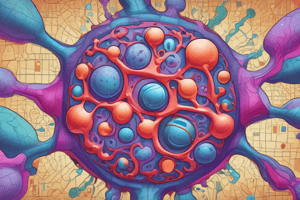Podcast
Questions and Answers
Where are B cells concentrated in lymph nodes?
Where are B cells concentrated in lymph nodes?
- Follicles located around the periphery (correct)
- Periarteriolar lymphoid sheaths
- Parafollicular cortex
- Germinal centers in the paracortex
What is the role of germinal centers?
What is the role of germinal centers?
- Activation of T lymphocytes
- Inhibition of B cell proliferation
- Maturation of dendritic cells
- Production of highly effective antibodies (correct)
Where are T lymphocytes concentrated in the spleen?
Where are T lymphocytes concentrated in the spleen?
- Germinal centers
- Follicles
- Paracortex
- Periarteriolar lymphoid sheaths surrounding small arterioles (correct)
What attracts and retains B cells in the follicles?
What attracts and retains B cells in the follicles?
What is the physiologic function of the immune system?
What is the physiologic function of the immune system?
Where are microbial antigens concentrated to increase the likelihood of T cells finding their antigens?
Where are microbial antigens concentrated to increase the likelihood of T cells finding their antigens?
Which cells remain in lymphoid organs and the bone marrow to secrete antibodies that find and eliminate microbes?
Which cells remain in lymphoid organs and the bone marrow to secrete antibodies that find and eliminate microbes?
What is the function of cytotoxic T lymphocytes (CTLs)?
What is the function of cytotoxic T lymphocytes (CTLs)?
What do B lymphocytes produce?
What do B lymphocytes produce?
Which chemokine is secreted by follicular dendritic cells (FDCs) to attract naive B cells into lymphoid organ follicles?
Which chemokine is secreted by follicular dendritic cells (FDCs) to attract naive B cells into lymphoid organ follicles?
Which chemokine receptor is expressed by naive T lymphocytes recognizing chemokines in the paracortex of lymph nodes and periarteriolar lymphoid sheaths of the spleen?
Which chemokine receptor is expressed by naive T lymphocytes recognizing chemokines in the paracortex of lymph nodes and periarteriolar lymphoid sheaths of the spleen?
Where do antigen-activated B and T cells migrate towards each other to interact?
Where do antigen-activated B and T cells migrate towards each other to interact?
What ensures cells interact and communicate after antigen exposure in lymphoid organs?
What ensures cells interact and communicate after antigen exposure in lymphoid organs?
Where are B cells primarily located in a histological section of a lymph node?
Where are B cells primarily located in a histological section of a lymph node?
Where do effector T cells exit to reach distant infection sites?
Where do effector T cells exit to reach distant infection sites?
What is the primary function of plasma cells in mucosal organs?
What is the primary function of plasma cells in mucosal organs?
Where do naive T lymphocytes primarily migrate from the blood into the T cell zones of lymph nodes?
Where do naive T lymphocytes primarily migrate from the blood into the T cell zones of lymph nodes?
How do naive T cells primarily enter lymph nodes?
How do naive T cells primarily enter lymph nodes?
How do naive T cells primarily remain in the paracortex of lymph nodes?
How do naive T cells primarily remain in the paracortex of lymph nodes?
What is the primary function of effector T cells at sites of infection?
What is the primary function of effector T cells at sites of infection?
Study Notes
Lymphocyte Migration and Interaction in Lymphoid Organs
- FDCs in follicles secrete a chemokine, CXCL13, recognized by naive B cells expressing the receptor CXCR5, which attracts B cells from the blood into lymphoid organ follicles.
- Naive T lymphocytes express CCR7, recognizing chemokines in the paracortex of lymph nodes and periarteriolar lymphoid sheaths of the spleen, segregating T cells in these regions.
- Upon antigen activation, lymphocytes alter their chemokine receptor expression, allowing antigen-activated B and T cells to migrate towards each other and interact at the edge of follicles.
- Lymphoid organ structure ensures cells interact and communicate after antigen exposure, exemplifying how cells recognizing an antigen interact and communicate when necessary.
- Histological section of a lymph node shows B cells in follicles and T cells in the parafollicular cortex, highlighting the anatomic segregation of T and B cells.
- Effector T cells exit lymph nodes and spleen, entering the circulation to reach distant infection sites, while some remain in lymphoid organs to help B cells produce antibodies.
- Naive lymphocytes recirculate between blood and secondary lymphoid organs, where they may be activated by antigens to become effector cells, and effector lymphocytes migrate to sites of infection.
- Effector T cells migrate to sites of infection to locate and eliminate microbes, while B cell–derived plasma cells secrete antibodies that circulate in the blood.
- Plasma cells in mucosal organs secrete antibodies combatting ingested and inhaled microbes in the lumen of these organs.
- Naive T lymphocytes migrate from the blood through high endothelial venules into the T cell zones of lymph nodes, where they are activated by antigens.
- T lymphocytes migrate into lymph nodes by binding to adhesion molecules and chemokines on the endothelial lining of high endothelial venules, remaining in the paracortex due to chemokine attraction.
- Naive T cells move around rapidly along specialized connective tissue fibers in the lymph node paracortex, scanning the surfaces of dendritic cells for antigens, forming stable conjugates upon recognition.
Studying That Suits You
Use AI to generate personalized quizzes and flashcards to suit your learning preferences.
Description
Test your knowledge on the migration and interaction of lymphocytes in lymphoid organs. Learn about the chemokines, receptors, and structural segregation that facilitate lymphocyte movement and communication.




